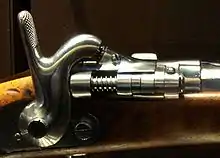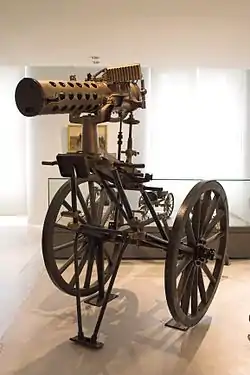

The Tabatière rifle was a breech-loading rifle of the French Army.
The Tabatière system was developed from 1864 as a way to convert numerous muzzle-loading weapons (usually Minié rifles) into breech-loading ones, in a process similar to that of the Snider-Enfield in Great Britain, Wänzl rifle in Austria, and the Springfield Model 1866 in the United States. The name "Tabatière" comes from the fact that the breech-loading mechanism looked like a snuff box.[1]

Most of the conversion work had been accomplished by the time of the Franco-Prussian War.[1] By July 1870, roughly 358,000 rifles had been converted, while 1.4 million muzzleloaders stayed in their original configuration.[2]
The ammunition was a center fire cartridge closely resembling a shortened 12 gauge shotgun shell. This weapon system was recognized as ballistically inferior to the Chassepot rifle, therefore it was used by second line troops and in defensive roles.[1]
These are commonly encountered today as "Zulu Guns", after rifles were converted into shotguns and sold cheaply in the early 1900s.
Models
- Tabatière rifle model 1867.[3]
Users
Conflicts
Paraguayan War[4] (Limited)
Notes
- 1 2 3 Stephen Shann French Army 1870–71 Franco-Prussian War (2), p. 38
- ↑ "Namslauer Stadtblatt. Zeitschrift für Tagesgeschichte" (PDF). bibliotekacyfrowa.pl (in German). Retrieved 18 April 2023.
- ↑ Stephen Shann French Army 1870–71 Franco-Prussian War (2), p. 45
- 1 2 Esposito, Gabriele, The Paraguayan War 1864–70: Osprey Publishing (2019)
- 1 2 "Unidades y armas durante el sitio de Buenos Aires de 1880" (PDF).
